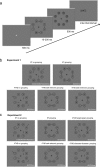Interaction between object-based attention and pertinence values shapes the attentional priority map of a multielement display
- PMID: 26752732
- PMCID: PMC4873047
- DOI: 10.1037/xhp0000194
Interaction between object-based attention and pertinence values shapes the attentional priority map of a multielement display
Abstract
Previous studies have shown that the perceptual organization of the visual scene constrains the deployment of attention. Here we investigated how the organization of multiple elements into larger configurations alters their attentional weight, depending on the "pertinence" or behavioral importance of the elements' features. We assessed object-based effects on distinct aspects of the attentional priority map: top-down control, reflecting the tendency to encode targets rather than distracters, and the spatial distribution of attention weights across the visual scene, reflecting the tendency to report elements belonging to the same rather than different objects. In 2 experiments participants had to report the letters in briefly presented displays containing 8 letters and digits, in which pairs of characters could be connected with a line. Quantitative estimates of top-down control were obtained using Bundesen's Theory of Visual Attention (1990). The spatial distribution of attention weights was assessed using the "paired response index" (PRI), indicating responses for within-object pairs of letters. In Experiment 1, grouping along the task-relevant dimension (targets with targets and distracters with distracters) increased top-down control and enhanced the PRI; in contrast, task-irrelevant grouping (targets with distracters) did not affect performance. In Experiment 2, we disentangled the effect of target-target and distracter-distracter grouping: Pairwise grouping of distracters enhanced top-down control whereas pairwise grouping of targets changed the PRI. We conclude that object-based perceptual representations interact with pertinence values (of the elements' features and location) in the computation of attention weights, thereby creating a widespread pattern of attentional facilitation across the visual scene. (PsycINFO Database Record
(c) 2016 APA, all rights reserved).
Figures






Similar articles
-
Identifying bottom-up and top-down components of attentional weight by experimental analysis and computational modeling.J Exp Psychol Gen. 2013 May;142(2):510-35. doi: 10.1037/a0029631. Epub 2012 Aug 13. J Exp Psychol Gen. 2013. PMID: 22889161
-
Perceptual organization, visual attention, and objecthood.Vision Res. 2016 Sep;126:34-51. doi: 10.1016/j.visres.2015.07.008. Epub 2015 Oct 23. Vision Res. 2016. PMID: 26440865
-
Object-based target templates guide attention during visual search.J Exp Psychol Hum Percept Perform. 2018 Sep;44(9):1368-1382. doi: 10.1037/xhp0000541. Epub 2018 May 3. J Exp Psychol Hum Percept Perform. 2018. PMID: 29723006
-
To Grasp the World at a Glance: The Role of Attention in Visual and Semantic Associative Processing.J Imaging. 2021 Sep 20;7(9):191. doi: 10.3390/jimaging7090191. J Imaging. 2021. PMID: 34564117 Free PMC article. Review.
-
The CODE theory of visual attention: an integration of space-based and object-based attention.Psychol Rev. 1996 Oct;103(4):603-49. doi: 10.1037/0033-295x.103.4.603. Psychol Rev. 1996. PMID: 8888649 Review.
Cited by
-
TVA-Based Assessment of Visual Attention Using Line-Drawings of Fruits and Vegetables.Front Psychol. 2018 Feb 27;9:207. doi: 10.3389/fpsyg.2018.00207. eCollection 2018. Front Psychol. 2018. PMID: 29535660 Free PMC article.
-
Activity in the Fronto-Parietal and Visual Cortex Is Modulated by Feature-Based Attentional Weighting.Front Neurosci. 2022 Apr 25;16:838683. doi: 10.3389/fnins.2022.838683. eCollection 2022. Front Neurosci. 2022. PMID: 35546874 Free PMC article.
References
Publication types
MeSH terms
Grants and funding
LinkOut - more resources
Full Text Sources
Other Literature Sources

